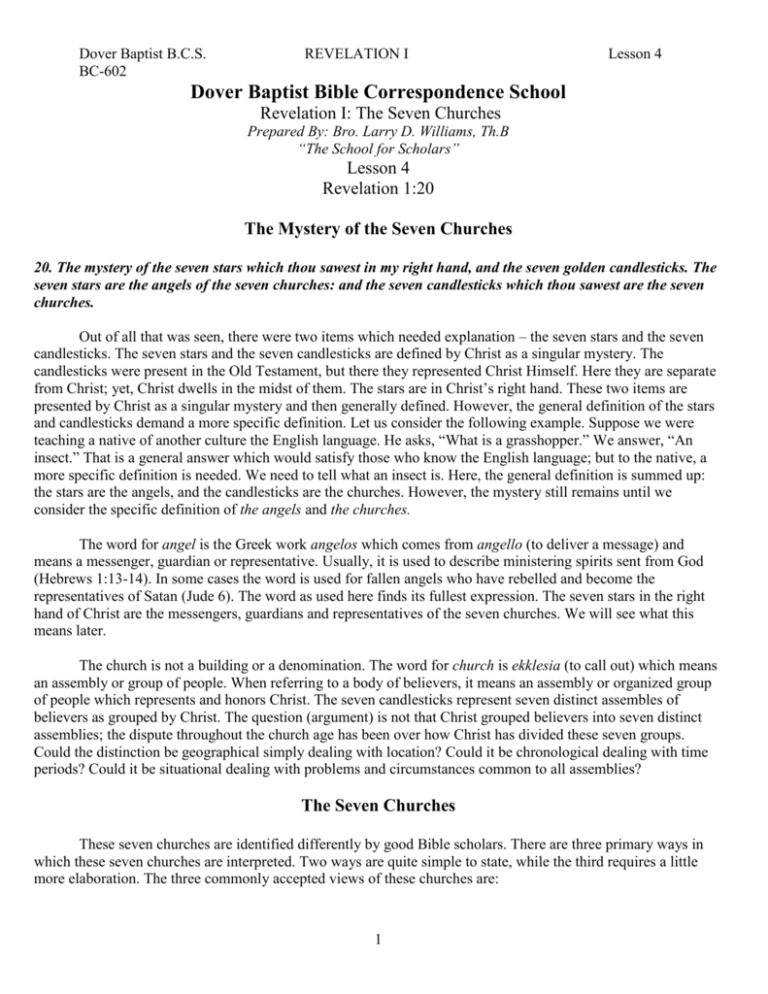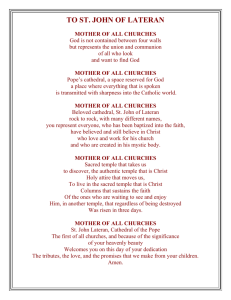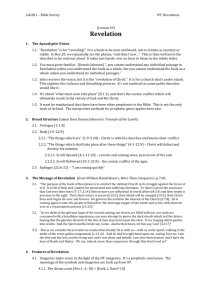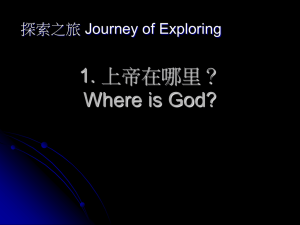The Revelation: The Seven Churches
advertisement

Dover Baptist B.C.S. BC-602 REVELATION I Lesson 4 Dover Baptist Bible Correspondence School Revelation I: The Seven Churches Prepared By: Bro. Larry D. Williams, Th.B “The School for Scholars” Lesson 4 Revelation 1:20 The Mystery of the Seven Churches 20. The mystery of the seven stars which thou sawest in my right hand, and the seven golden candlesticks. The seven stars are the angels of the seven churches: and the seven candlesticks which thou sawest are the seven churches. Out of all that was seen, there were two items which needed explanation – the seven stars and the seven candlesticks. The seven stars and the seven candlesticks are defined by Christ as a singular mystery. The candlesticks were present in the Old Testament, but there they represented Christ Himself. Here they are separate from Christ; yet, Christ dwells in the midst of them. The stars are in Christ’s right hand. These two items are presented by Christ as a singular mystery and then generally defined. However, the general definition of the stars and candlesticks demand a more specific definition. Let us consider the following example. Suppose we were teaching a native of another culture the English language. He asks, “What is a grasshopper.” We answer, “An insect.” That is a general answer which would satisfy those who know the English language; but to the native, a more specific definition is needed. We need to tell what an insect is. Here, the general definition is summed up: the stars are the angels, and the candlesticks are the churches. However, the mystery still remains until we consider the specific definition of the angels and the churches. The word for angel is the Greek work angelos which comes from angello (to deliver a message) and means a messenger, guardian or representative. Usually, it is used to describe ministering spirits sent from God (Hebrews 1:13-14). In some cases the word is used for fallen angels who have rebelled and become the representatives of Satan (Jude 6). The word as used here finds its fullest expression. The seven stars in the right hand of Christ are the messengers, guardians and representatives of the seven churches. We will see what this means later. The church is not a building or a denomination. The word for church is ekklesia (to call out) which means an assembly or group of people. When referring to a body of believers, it means an assembly or organized group of people which represents and honors Christ. The seven candlesticks represent seven distinct assembles of believers as grouped by Christ. The question (argument) is not that Christ grouped believers into seven distinct assemblies; the dispute throughout the church age has been over how Christ has divided these seven groups. Could the distinction be geographical simply dealing with location? Could it be chronological dealing with time periods? Could it be situational dealing with problems and circumstances common to all assemblies? The Seven Churches These seven churches are identified differently by good Bible scholars. There are three primary ways in which these seven churches are interpreted. Two ways are quite simple to state, while the third requires a little more elaboration. The three commonly accepted views of these churches are: 1 Dover Baptist B.C.S. REVELATION I Lesson 4 BC-602 1) They represent only literal churches of John’s day. This statement is very true in itself. The seven churches were true churches that really existed. However, this group chooses to limit the application of these churches to the actual churches of that day. In brief: this is a mere accurate historical account. Indeed, a very safe position, but the question is, does this view allow us the full benefit of the passage? 2) They represent different kinds of churches with different kinds of problems and opportunities at any time during the Church Age. For example: an Ephesian type of church would be a church that has become sidetracked from dedication to and adoration of Christ; a Laodicean type of church is one that has become apathetic in worship and service, etc. This group does not deny the existence of each literal church, but expands the application beyond those churches of John’s day. A very balanced and practical view. 3) The third view requires a lot more explanation. Those holding this view believe that these seven churches represent seven groups of people who are assembled for a period of time to represent Christ in the world. In brief; Each church represents a particular period of time during the Church Age. We will refer to this view as the “period theory.” According to this view, Ephesus describes the early apostolic church (30-90 AD); Smyrna, the persecuted church (90-300 AD); Pergamos, the founding of the “state church” (300-590 AD); Thyatira, the Dark Ages (590-1500 AD); Sardis, the Protestant Reformation (1500-1750 AD); Philadelphia, the “open door” church (1750-1930 AD); and Laodicea, the present apathetic church. These dates are approximate, and the changes were gradual with many overlaps. Those who hold this position are accused of being too speculative and driving round ideas in square holes. None of these views can be totally and dogmatically proven, and any one or all three of these could be true. On the other hand, none of these views are heresy. The student must weigh the evidence and come to his/her own conclusion. The Seven Stars/Angels Because of the different views of whom or what the seven churches represent, there are also different views as to who or what the seven stars represent. 1) To those who view the churches as referring only to the actual churches of John’s day, the seven stars would simply represent the pastor of each church. 2) To those who view the churches as referring to church characteristics, the stars would also represent the pastor, or even, the administration of any church. 3) According to the “period theory,” the seven stars are the seven messengers and guardians of the seven churches which are seven groups of people who faithfully represent Christ. A representative must give a true picture of the one he is representing. Otherwise, the ones He is being represented to will get the wrong idea of Him. It is the church’s responsibility to represent Christ in the world. We are His ambassadors (II Cor. 5:20) However, it is the stars’ responsibility to make sure that Christ is properly represented. In other words, the seven candles represent the churches giving light in the face of Christ in a dark world. Simply stated: Making Christ known. “For we preach not ourselves, but Christ Jesus the Lord; and ourselves your servants for Jesus’ sake. For God, who commanded the light to shine out of darkness, hath shined in our hearts, to give the light of the knowledge of the glory of God in the face of Jesus Christ. But we have this treasure in earthen vessels, that the excellency of the power may be of God, and not of us.” (II Cor. 4:5-7) The seven stars are viewed as those who contend that this must be pure light and must be directed toward Christ and not man, or even the church itself. 2 Dover Baptist B.C.S. REVELATION I Lesson 4 BC-602 The seven candlesticks represent anyone who claims to represent Christ during the church age. However, the stars are those who truly and faithfully represent Christ. Biblical Basis for the “Period Theory” The foundation of the “Period Theory” is built upon the distinctions set forth in the Word of God. Distinction #1: There is a difference between someone who merely professes Christ and someone who really possesses Christ. In other words, there is a difference between merely saying that you are a Christian and being a Christian. We merely just don’t believe, but we act and do what we believe in obedience to the Lord. Everyone who claims to be a Christian is acting as a representative of Christ. By their actions, they are saying that their life represents what Christ is really like. Most of us fail in this very area as the result of our behavior around others. A mere professor of Christ will misrepresent Christ to the world while a true believer will seek to honor the biblical teaching about Christ in every area of his/her life. Distinction #2: There is a difference between Christendom and Christianity. Christendom includes all who name Christ as Savior, leader, etc. Christianity includes only those who are truly saved. Christendom is the entire group of people who profess that Christ is their Savior, while genuine Christianity is the group within the professing group who truly know Christ as their personal Savior. Please remember that a person must profess Christ before he/she can know Him as Savior (Romans 10:9-13); but not all who profess Christ are truly trusting Him in their heart (Matt. 7:21). “Period Theory” Conclusion: The seven candlesticks could represent the entire professing church from the beginning to the end. These candlesticks are supposed to show light on the face of Christ that the world can see a true picture of Him “But if our gospel be hid, it is hid to them that are lost: In whom the god of this world hath blinded the minds of them which believe not, lest the light of the glorious gospel of Christ, who is the image of God, should shine unto them. For we preach not ourselves, but Christ Jesus the Lord; and ourselves your servants for Jesus’ sake. For God, who commanded the light to shine out of darkness, hath shined in our hearts, to give the light of the knowledge of the glory of God in the face of Jesus Christ.” (II Cor. 4:3-6) It is interesting to see Christ in the midst of the candlesticks (assembly) at the beginning of the church age and outside knocking to get into the hearts of individuals at the close (Chapter 3:20). The candlesticks represent Christendom and the complete history of the professing church. Within (among) the professing church (Christendom), there are true believers (Christians). The seven stars represent the true messengers of the church age. As the professing church drifts farther and farther away from Christ into darkness, the stars are drawn closer and shine brighter. These are the angels (messengers) who know the truth and are responsible to proclaim truth and denounce error. Example: in the Pergamos church, Satan dwells in and has a seat there. Although this may be true in many religious professing assemblies (Christendom), it could never be true in the real body of Christ (Christianity). But, in the midst of Pergamos assembly, there were those who did not deny the faith. The true believers are the stars in Christ’s hand who are responsible to cast a true light in His face as the artificial light of the professing church (candlesticks) dims, flickers and goes out. The seven candlesticks are seven periods in church history and the seven stars are those who were faithful witnesses during each period. That is why Christ referred to the seven stars and candlesticks as “the things which are.” 3 Dover Baptist B.C.S. REVELATION I Lesson 4 BC-602 In Summary, according to the “period theory,” the seven churches represent the entire professing church (Christendom) from the giving of the Holy Spirit at Pentecost up to the rapture. The seven stars represent the true believers (Christianity) dwelling among the false professors. There is a vast difference between Christendom and Christianity. Christendom includes all who profess Christ whether or not the profession is genuine. Christianity, on the other hand, is made up of those who not only profess Christ with their mouths, but also possess Him in their hearts. Clarification: The “period theory” does not deny the past historical accuracy of the literal churches or their practical application to present churches. Because of the prophetic/historical nature of The Revelation Chapters 2 and 3, the study of the seven churches will yield faith strengthening substance and encouragement to all true believers. Remember that in the Old Testament, the qualifications for a prophet required that he give a short range prophecy; and if it came to pass, his long range prophecy could be accepted as from God (Deut. 18:18-22). These two chapters are a running short range prophecy that establishes the credibility of the long range prophesies from Chapter 4 to the end of the Revelation. Let me explain. When John wrote the Revelation, the seven church periods were all still in the future because he was in the Ephesian period at the beginning of the Church Age. Today, we are living in the Laodicean period and can look back (as we will do in these seven studies) and see how accurately each period was fulfilled. John saw the entire Church Age in a vision; but as each period unfolded, following generations of believers witnessed the actual fulfillment. That is why those in every period are given the challenge “he that hath an ear, let him hear what the Spirit saith unto the churches.” As the church age progressed from period to period, each group could understand what was going on by studying these seven churches. Also, they could stand assured as they noticed how accurately the Word of God foretold the characteristics of the previous period. Most of us in the present Laodicean period realize that we are living in a lukewarm, apathetic time; but we can remember the great “open door” of the previous Philadelphian period with its great revivals and awakenings. John saw these seven periods as prophesy: today, we see them as history. Therefore, we have the added assurance and confidence that the things prophesied in Chapters 4 through 22 will also be fulfilled. This is the special blessing to those who study the Revelation. Caution Concerning Views and Theories Whatever “view” or “theory” one chooses to take, the central truth is the responsibility of true believers to be Christ like in their living as the “light of the world” and good soldiers in their defense of the faith once delivered to the saints. The promotion of purity in life, faith and doctrine is the responsibility of every believer in every local church throughout the Church Age. Keep in mind that every passage of Scripture has a Historical, Dispensational and Practical application, and the Book of Revelation is no different. Verse 2 of Chapter 1 explains that John was to treat the Revelation as all other Scripture. He was to bare record of the Word of God (Historical), the testimony of Jesus Christ (Dispensational) and then the things he saw (Practical). As we study these seven churches, we will notice the literal historical church to which John wrote; the dispensational church as it represents a period in church history; and the practical application to our everyday lives. In reality, all three views of theses churches are valid to some degree. The student must choose the proper blend of the historical, dispensational, and practical applications of these churches. Therefore, all three views will be presented in this study. Above all, the student must avoid extremism in areas of Bible study where other views must be respected. The Word of God is clear and settled on the fundamental doctrines concerning salvation and practical Christian living. However, New Testament prophesy should be an exciting, challenging, and rewarding study. The main 4 Dover Baptist B.C.S. REVELATION I Lesson 4 BC-602 thing to remember is that although new light may be discovered, new truth will not be discovered. The truth of the Gospel is complete, full, and settled. Therefore, God given “new light” will always enforce the truth rather than seek to alter pr replace it. The Revelation Epistle is light given to and in harmony with established truth. Paul wrote the following statement some thirty years before the Revelation was written by John, concerning established truth: (Read Galatians 1:3-9). There is no other gospel, but the gospel of Jesus Christ! Assignment for the Next Lesson: Read Revelation Chapter 2. 5 Dover Baptist B.C.S. BC-602 REVELATION I Lesson 4 Revelation I: The Seven Churches Lesson 4 Exam Name: ______________________________________ Grade: ________________ 1. The seven stars and the seven candlesticks are defined by Christ as a ______________________ mystery. (Value 5 points) 2. Give the three possibilities as to how Christ grouped these assemblies? (Value 15 points) A) ______________________________ B) _________________________ C) __________________________ 3. Give the three commonly accepted views of these seven churches? (Value 15 points) A) ___________________________________________ B) _________________________________________ ________________________________________ C) ______________________________________________. 4. According to the “period theory” the seven churches describe and represent what? (Value 32 points) A) Ephesus ________________________ B) Smyrna ___________________________________. C) Pergamos “_______________________________________” D) Thyatira __________________________ E) Sardis ___________________________________________ F) Philadelphia “________________________” G) Laodicea ________________________________ church. None of these views are ____________________________. 5. Give the three different views as to whom or what the seven stars represent? (Value 15 points) A) _______________________________________________________________________________________ B) _______________________________________________________________________________________ C) _______________________________________________________________________________________ 6. Explain the difference between Christendom and Christianity? (Value 18 points) ______________________________________________________________________________ ______________________________________________________________________________ ______________________________________________________________________________ ______________________________________________________________________________ 6









